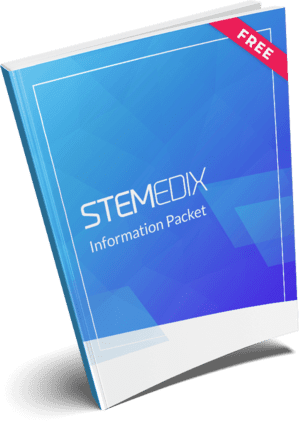
by admin | Mar 12, 2021 | Stem Cell Therapy, Mesenchymal Stem Cells, Osteoarthritis
Affecting over 52 million people, or nearly 25% of the adult patients, osteoarthritis (OA) continues to be the leading cause of disability for people in the United States. Occurring as a result of the protective cartilage, or articular cartilage, that cushions the ends of the bones breaking down, OA can occur in any joint, but most often causes pain, stiffness, and swelling in the hands, feet, knees, hips, and lower back[1][2].
To date, current conventional treatments employing pharmacological treatments have been developed to temporarily address the symptoms (i.e.: relieve pain, stiffness, and swelling) of OA, but have proven ineffective in preventing the onset, progression, or long-term symptoms of the condition. While there are a number of reasons conventional OA therapies have demonstrated themselves to be ineffective, the primary reason is that they do not regenerate the cartilage required to prevent the progressive degenerative process associated with OA.
However, recent studies exploring mesenchymal stem cell-based therapy for OA have demonstrated several potential benefits, including regenerating lost cartilage, slowing cartilage degeneration, pain relief, and improved patient mobility.
Currently, there have been a number of advancements in using cellular-based therapy for OA, including techniques such as autologous chondrocyte implantation (ACI) and treatment with embryonic stem cells (ESCs) and induced pluripotent stem cells (iPSCs). While all of these treatments have shown promise in the regeneration of cartilage, each has its own issues which limit its effectiveness and/or availability.
Of the cellular based therapies being evaluated, none demonstrate as much promise, with so few drawbacks, as treatment of OA-related cartridge degeneration with mesenchymal stem cells (MSCs). Sourced from a variety of tissue, including adipose, bone marrow, and synovium, MSC have demonstrated to be progenitor cells with the ability to differentiate into cartilage. Because of this, coupled with the low-level of risk and ease of production, MSCs are considered to be a realistic option, holding the best potential treatment of OA.
While each requires further study, a number of studies, both animal and human, exploring the effectiveness of MSCs gathered from adipose tissue, bone marrow, and synovium have all demonstrated varying degrees of success related to regeneration of cartilage lost as a result of OA progression.
As a result of the benefits resulting from previous studies examining the role of MSCs as a cell-based treatment for treating OA-induced cartilage degeneration and because of the effectiveness and high cost associated with current pharmacological-based treatments, the authors of this review call for further clinical study into more innovative and effective modalities to demonstrate the efficacy, safety, and benefits of MSCs in treating patients with OA.
Article Source: (2016, August 10). Therapeutic potential of mesenchymal stem cell based therapy for …. Retrieved from https://www.ncbi.nlm.nih.gov/pmc/articles/PMC4980326/
[1] “Osteoarthritis – Symptoms and causes ….” 22 Feb. 2020, https://www.mayoclinic.org/diseases-conditions/osteoarthritis/symptoms-causes/syc-20351925.
[2] “Osteoarthritis – Arthritis Foundation.” https://www.arthritis.org/diseases/osteoarthritis.

by admin | Feb 26, 2021 | Stem Cell Therapy, Mesenchymal Stem Cells, Multiple Sclerosis, Stem Cell Research
Multiple sclerosis (MS) is a progressive and disabling autoimmune disease that affects the brain and central nervous system. As MS progresses, the body’s immune system attacks the protective sheath (myelin) that covers nerve fibers resulting in axonal damage and loss that eventually results in paralysis of the limbs; the condition also contributes to a number of other serious communication problems between your brain and the rest of the body[1], including numbness, tremors, and issues affecting vision and speech.
To date, no effective therapeutic medication or treatment for MS exists and medication prescribed for this disease is done so for the purpose of alleviating symptoms and chronic inflammation associated with it; several of these drugs, and especially those with immunomodulatory and immunosuppressive properties have demonstrated to be only partly effective in easing autoimmune reactions.
While current immunotherapies have demonstrated to be effective in reducing the reactivity of autoimmune anti-myelin and MS relapse rate, there remains no approved method for treating or slowing progression of the disease or for repairing myelin damaged as a result of it. As a result, Bejargafshe et al. point out that finding an appropriate clinical treatment for improvement of the neurological damage caused by MS is essential.
The authors also call attention to the numerous studies demonstrating the benefits of mesenchymal stem cells (MSCs) in creating a number of different of autoimmune conditions, including modulating the immune response in MS patients. MSCs are specific multipotent and self-renewing stem cells that have demonstrated to be differentiated into several cell types and can be easily isolated from bone marrow and adipose tissue; this means the patient can serve as a donor for him/herself without risk of rejection.
Bejargafshe et al.’s study reviews several clinical trials evaluating the effectiveness of MSC therapy for MS patients, including several specific clinical trials examining the effectiveness of bone marrow-derived MSCs, adipose-derived MSCs (ADMSCs), USMSCs, human fetal-derived neural stem cells (hNSCs), MSC-derived neural progenitors (MSC-NPs), and hematopoietic stem cells (HSC).
The authors of this study conclude that cell-based therapies, including those mentioned in this study, have shown to repair the CNS, protect against inflammation caused by an autoimmune response, are safe and effective, and demonstrate new opportunities for preventing and treating a wide range of neurodegenerative diseases, including MS.
In addition, the authors concluded that while nearly all of the various types of stem cells evaluated provide benefits, adult MSCs, because of their safety and ease of extraction, are the most common source of stem cells used for this application, with bone marrow being the major source of MSCs used. Clinical trials indicate the observed multipotency and highly-differentiated potential of UC stem cells also make them a viable treatment option, but the need to maintain a supply of UC stem cells through cell banks limit their appeal on the basis of availability.
Interestingly, among the potential cell therapies evaluated, adult adipose stem cells (ASC) appear to be among the most suitable cells for the treatment of MS. In addition to being very safe to use, adult ASCs are easy to separate from adipose tissue, are available from several different parts of the body, are available in a large concentration per unit area, and relatively inexpensive when used in a stem cell transfusion. Considering the benefits listed above, as well as those observed in clinical studies, the authors conclude that ASCs and HSCs are appropriate candidates for the treatment of MS.
Source: (2019, December 27). Safety and efficacy of stem cell therapy for treatment of neural …. 1, from https://www.ncbi.nlm.nih.gov/pmc/articles/PMC6987330/
[1] “Multiple sclerosis – Symptoms and causes ….” 12 Jun. 2020, https://www.mayoclinic.org/diseases-conditions/multiple-sclerosis/symptoms-causes/syc-20350269.

by admin | Feb 19, 2021 | Multiple Sclerosis, Mesenchymal Stem Cells, Stem Cell Research, Stem Cell Therapy
Progressive multiple sclerosis is a significant disruptive neurodegenerative disease that interferes with the brain’s ability to control the body; the condition continues to get worse over time and, to date, has no known therapeutic treatment or cure.
Petrou Et. Al’s double-blind clinical trial examined the therapeutic efficacy of mesenchymal stem cell (MSC) transplantation in active progressive multiple sclerosis and explored the most favorable route of cell delivery (intravenous or intrathecal injections).
Prior to this study, previous trials examining various types of MSC administration in the therapeutic treatment of multiple sclerosis have demonstrated the clinical safety of MSC administration but have not identified treatments to suppress central nervous system (CNS) inflammation associated with the progression of diseases like progressive multiple sclerosis.
Several studies have also demonstrated that CNS loses the ability to repair and regenerate over time. Considering that stem cells, and specifically MSCs, have demonstrated to provide additional benefits, including immunomodulatory and neurotrophic effects, when used in the treatment of stroke and multi-system atrophy, they appear to be a viable potential therapeutic treatment for active progressive multiple sclerosis.
For the purposes of Petrou Et. Al’s study, a total of 48 participants with a mean disease (active progressive multiple sclerosis) duration of 12.70 years were included as part of this study either as part of a placebo group, MSC-IV group, or MSC-IT group; selected treatment was applied at 3-month and 6-month marks of the study.
At the conclusion of this study, the authors report no serious, treatment-related adverse effects were observed and significantly fewer patients in the MSC-IT and MSC-IV groups experienced treatment failure when compared to the placebo group.
By reviewing changes observed in ambulation index, the sum of functional scores, 25-foot timed walking test, PASAT and OWAT/KAVE cognitive test, and the rate of change in T2 lesion load on MRI observed after the 6th-month treatment, researchers also found beneficial effects in both the MSC-IT and MSC-IV groups.
It appears that repeated intrathecal injection of MSC during the second round of treatment (Month 6) significantly improved the effects measured during the first round of similar treatment (Month 3); similar, but less significant benefits were also observed in the MSC-IV group. Specifically, researchers report that these observed benefits may indicate the involvement of immunomodulatory and neuroprotective mechanisms.
Of particular interest is the fact that the benefits with clinical significance were observed in participants with progressive multiple sclerosis found to be previously unresponsive to conventional immunotherapies and currently with limited treatment options.
In conclusion, this study found short-term clinical efficacy and perhaps neuroprotection by administration of MSCs to participants with progressive multiple sclerosis. The researchers also found that while repeated injections of both MSC-IT and MSC-IV produced beneficial effects, intrathecal administration appears to produce more clinically significant and observable benefits than MSC-IV.
These findings are recommended for use in the design of future studies examining the impact of cell therapy on neurodegeneration and neuronal regeneration and warrant Phase III study to confirm the therapeutic potential of cellular therapy in neurodegenerative and neuroinflammatory diseases, including multiple sclerosis.
Source: (2020, December 1). Beneficial effects of autologous mesenchymal stem … – PubMed., from https://pubmed.ncbi.nlm.nih.gov/33253391/

by admin | Feb 12, 2021 | Glaucoma, Mesenchymal Stem Cells, Stem Cell Therapy
Glaucoma is a complex group of interrelated eye conditions that affects over 70 million people worldwide. A leading cause of irreversible blindness in people over 60, glaucoma is a progressive condition that affects the optic nerve and leads to gradual loss of specific neurons that relay visual information from the retina to the brain; the progressive vision loss caused by glaucoma is often associated with increased pressure in the eyes[1].
Currently, pharmaceutical and surgical treatment for glaucoma focus on relieving pressure in the eye by treating the trabecular meshwork (TM), the part of the eye that relieves pressure by allowing drainage of the aqueous humor. Unfortunately, to date, these treatment options have demonstrated only to delay, not correct, or prevent, the progression of glaucoma. Additionally, these treatment options are not effective in repopulating or regenerating the retinal ganglion cells (RGCs), the neurons that relay visual information to the brain; in other words, these treatments have proven largely ineffective in patients with advanced stages of glaucoma.
With the advances made in stem cell therapy, and especially considering the functional properties of mesenchymal stem cells (MSCs), several new therapeutic approaches to treating glaucoma-related issues are currently being considered.
In this review article, Harrell et. al drew key observations from the information presented in over 250 journal articles to assess the current knowledge and future perspectives when considering the beneficial effects of MSCs in the treatment of glaucoma.
Specifically, researchers have found that the neurotrophins produced by MSCs encourage both the survival and regeneration of RGCs affected by glaucoma; MSCs appear to support RGCs by generating cells that are similar to RGCs and through promoting the expansion and differentiation of retinal stem cells (RSCs) in RGCs. MSCs are also believed to support the integrity of TM cells, allowing for pressure in the eyes to be reduced.
After reviewing the abstracts of 253 journal articles on the topic, the authors of this review concluded that the large number of studies examining MSCs’ ability to treat and/or protect the eye from the harmful effects of glaucoma was primarily dependent on MSCs capacity to provide neuroprotection for, and support regeneration in, RGCs.
However, as the authors point out, while several of these studies appear to demonstrate the potential benefits of MSCs and their secretome in glaucoma therapy, neither the safety nor efficacy have been validated in clinical settings or clinical trials with the appropriate number of enrolled patients.
While there appear to be several beneficial effects associated with using MSCs and their secretome in glaucoma therapy in humans, the authors conclude that these claims can only be verified if MSC-dependent therapeutic effects are confirmed through future clinical trials.
Source: (n.d.). Therapeutic Potential of Mesenchymal Stem Cells and … – Hindawi from https://www.hindawi.com/journals/sci/2019/7869130/
[1] “Glaucoma – Symptoms and causes – Mayo Clinic.” 23 Oct. 2020, https://www.mayoclinic.org/diseases-conditions/glaucoma/symptoms-causes/syc-20372839.

by admin | Feb 5, 2021 | ALS, Mesenchymal Stem Cells, Stem Cell Research, Stem Cell Therapy
Amyotrophic lateral sclerosis (ALS), also known as motor neuron disease or Lou Gehrig’s disease, is a disease that gradually paralyzes people because the brain is no longer able to communicate with the muscles of the body that we are typically able to move at will[1]; as ALS progresses, people will lose the ability to walk, talk, swallow, and eventually breathe.
While no treatment to prevent or even slow the progression of, ALS currently exists, recent findings indicate that neurotrophic factors (NTFs) have been shown to potentially improve the survival of motor neurons in ALS. While a single administration of NTFs has not been effective in extending the life of these motor neurons, the review suggests the direct delivery of multiple NTFs by transplantation to the CNS has proven effective in animal studies.
Specifically, the observed benefits of mesenchymal stem cells (MSC) transplanted from bone marrow or adipose suggest improved neurological stabilization in patients with ALS. As such, the authors of this review have developed a method that produces a strong synergistic effect when introducing a combined delivery of neurotrophic factors in patients with ALS.
The authors, in this review, report on the safety and clinical effects resulting from phase 1 / 2 and 2a clinical trials in which autologous MSC-NTS cells were transplanted in patients with ALS. Both of these studies were considered open-label proof of concept studies where patients were followed up for 3 months before transplantation and 6 months after receiving MSC-NTS transplantation.
No serious adverse events were associated with MSC-NTF cells intramuscular (IM) injections, intrathecal injections (IT), or a combination of both (IT+IM) during these studies.
Additionally, neurotrophic growth factor secretion of patients’ cells was shown to be induced in the MSC-NTF cells when compared to MSCs of the same patient prior to differentiation. In all samples, MSC-NTF cells demonstrated increased secretion of NTFs when compared to non-differentiated MSCs from the same patient.
As a result of this study, the authors have concluded that IT and IM injections of MSC-NTF cells in patients with ALS are safe and well-tolerated. While not the primary focus of the study, the findings also demonstrated clinically meaningful benefits specifically induced by intrathecal treatment with MSC-NTF cells, including potentially slowing the rate of ALS progression.
Considering that neurologists specializing in the treatment of ALS consider a reduction in ALS-FRS-R slope of 25% or more to be clinically significant, the change in ALS progression rate observed after MSC-NTF cell transplantation in this study may indicate a clinically meaningful effect to be confirmed in future clinical trials.
Source: (n.d.). Safety and Clinical Effects of Mesenchymal Stem Cells Secreting …. Retrieved from https://pubmed.ncbi.nlm.nih.gov/26751635/
[1] “Amyotrophic lateral sclerosis (ALS) – Symptoms and causes – Mayo ….” 6 Aug. 2019, https://www.mayoclinic.org/diseases-conditions/amyotrophic-lateral-sclerosis/symptoms-causes/syc-20354022. Accessed 15 Feb. 2021.

by admin | Jan 8, 2021 | Stem Cell Therapy, Heart Failure, Mesenchymal Stem Cells, Stem Cell Research
After a decade of research, the safety and efficacy of intravenous infusion of bone-marrow-derived stem cells for therapeutic treatment in individuals with heart failure have been well established; however, until Bartolucci et al’s phase 1 / 2 randomized controlled trial of intravenous infusion umbilical cord mesenchymal stem cells (UC-MSCs) on heart disease, no clinical studies have examined the safety and efficacy of similar intravenous infusion of UC-MSCs in patients with chronic systolic heart failure (HFrEF).
Specifically, therapeutic treatment of heart failure with stem cells harvested from bone marrow has demonstrated improved cardiac function and regeneration of damaged heart tissue resulting in moderate clinical benefits in survival, left ventricular function, and improved quality of life in patients with HFrEF.
While MSCs isolated from adult bone marrow have demonstrated benefits, the invasive harvesting procedure and differentiation potential related to donor age and comorbidity associated with BM-MSC present several disadvantages when evaluating for clinical application.
On the other hand, when compared to BM-MSCs, umbilical cord-derived MSCs, or UC-MSCs, are easily attainable, demonstrate less cellular aging, and are not obstructed by potential ethical concerns.
With preclinical research demonstrating UC-MSC supporting enhanced vascular regeneration and cardiomyocyte protection, Bartolucci et al’s study aimed to evaluate the safety and efficacy of intravenous infusion of UC-derived stem cells for therapeutic treatment in individuals with heart failure.
This RIMECARD trial was the first randomized, double-blind, placebo-controlled study of intravenous infusion of allogeneic UC-MSCs in patients with chronic HFrEF. Although there has been limited experience on intravenous administration of MSCs in patients with cardiovascular diseases, it has been well established that MSC-based therapies are considered safe for therapeutic use in this application; further review of prospective clinical trials also did not detect a risk of infusion toxicity, organ system complications, infection, death, or malignancy in treated patients.
The results of the RIMECARD trial demonstrated that delivery of UC-MSCs seems safe for use in the HFrEF population with observable improvements in LVEF in patients receiving intravenous UC-MSC treatments. Researchers have proposed many potential reasons for the clinical benefits of the application of UC-MSCs among patients with heart failure including reduction in myocardial cell apoptosis, less myocardial inflammation and myocardial fibrosis, the formation of new cardiac-related blood vessels, and increased cell differentiation.
One notable observation of this study was the notable cardiomyogenic differentiation potential between UC-MSCs and BM-MSCs. It appeared that BM-MSCs presented a more favorable profile of transcription factors related to cardiac differentiation; however, findings demonstrating poor retention rates after intramyocardial injections of BM-MSCs render them potentially insufficient for what is required to be deemed clinically beneficial.
By comparison, the paracrine factors observed demonstrate a significant advantage of UC-MSCs over BM-MSCs with the most prominent difference being the expression of hepatocyte growth factor in UC-MSCs from all tested donors (BM-MSCs showed low to undetectable levels).
While further analysis and outcomes were considered limited based on small patient sample groups, IV infusion of UC-MSCs was found to be feasible and safe among patients with HFrEF, inducing no humoral immune response among test subjects. While findings suggest significant improvements in left ventricular function, functional status, and quality of life, the impact of UC-MCSs in patients with heart failure would be further supported through larger clinical trials.
Reference: (2017, September 26). Safety and Efficacy of the Intravenous Infusion of Umbilical …. Retrieved December 28, 2020, from https://www.ahajournals.org/doi/10.1161/CIRCRESAHA.117.310712







 St. Petersburg, Florida
St. Petersburg, Florida
